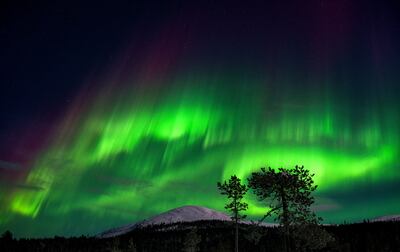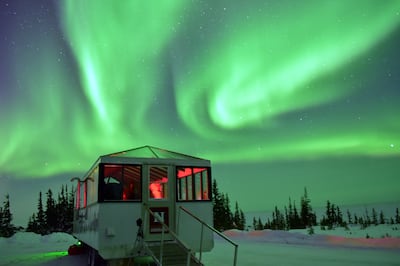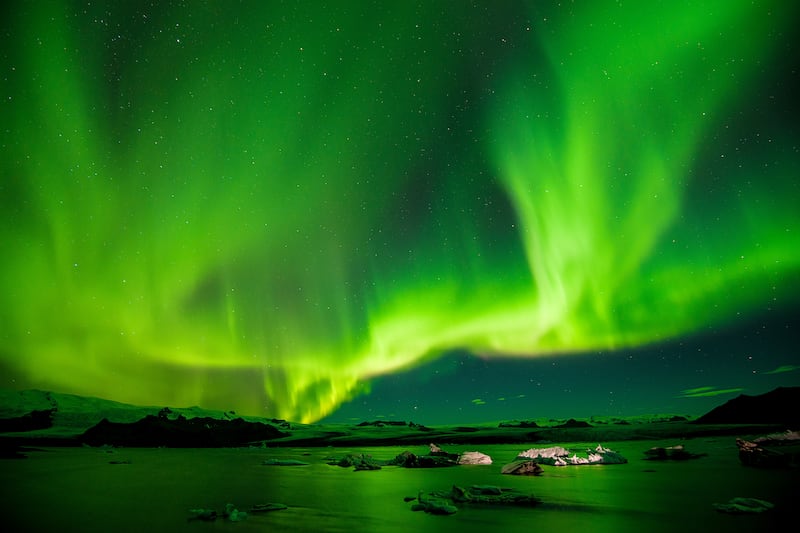Witnessing the aurora borealis, or the northern lights, in all their glory is common on travel bucket lists, but now more than ever.
Whether you want to see them in Finnish Lapland, Shetland in Scotland or Churchill, Canada, there has never been a better time to see this celestial phenomenon as visibility is projected to be better than it has been in more than a decade.
Interest in the spectacle, which is typically only seen over the Arctic Circle, also peaked in November as a major geomagnetic storm meant people were able to enjoy the show as far south as Italy and Greece.
A recent study by Expedia shows it is the most sought-after global experience of the year. It's more in-demand than going on an African safari, exploring Japan during cherry blossom season or visiting Machu Picchu in Peru, the travel tech company reports.
Searches on its platform for winter trips to northern lights “capitals”, such as Finland, Canada and Norway, are skyrocketing.
What are the northern lights?

The northern lights are an atmospheric phenomenon that turns the night sky into a canvas of shimmering shades of blue, red, yellow, green and purple.
It was named aurora borealis by Italian astronomer Galileo Galilei in 1619, but records of the spectacle had already existed for centuries, the earliest believed to be a 30,000-year-old cave painting in France.
It's the sun that causes an aurora, which happen in the north and south poles, although the latter is referred to as aurora australis.
During a particular type of solar storm, the sun shoots bubbles of electrified gas at high speeds into the magnetic field lines at the poles and into the Earth's atmosphere where these particles interact with gases, according to Nasa.
This results in one of nature's most illuminating light displays, as oxygen creates green and red light, while nitrogen glows blue and purple.
While this is happening 24 hours a day, travellers need to be in the right place at the right time to see it in the way we see in photographs. This will usually be between September and April, 9pm to 3am, when the sky is at its darkest.
Why are they so visible in 2024?
Solar activity influences the intensity of the aurora borealis. The sun goes through an 11-year cycle of solar maximum – when the sun is more active – and solar minimum, and experts have predicted this year coincides with a solar maximum.
This means there are a larger number of sunspots, or areas on the sun's surface with strong magnetic activity, leading to more frequent and visible displays of the northern lights.
An increase of solar storms also has an impact, as these eruptions on the sun's surface release huge amounts of solar particles, according to theweather.com.
Where to get the best view

While experts say that during periods of heightened solar activity the lights may also be visible at lower latitudes (as demonstrated in November), aurora-seekers are better off heading to the Arctic Circle and picking areas with limited light pollution. Locations with international dark sky certification listed on darksky.org, for example, offer the ideal viewing conditions.
Top northern lights destinations include Greenland, Iceland, Norway and Svalbard, a Norwegian archipelago that's one of the northernmost inhabited areas in the world.
Expedia has noted a huge spike in interest for Lapland, Finland, with 370 per cent more people searching for the destination year on year. Other trending locations for aurora-viewing on the platform include Churchill, Banff and Jasper in Canada; Alta and Narvik in Norway; Kalfafell in Iceland; the Isle of Skye in the UK; and Abisko and Kiruna in Sweden.
When to go
The equinoxes of March and October are widely considered to be the best time to see the most visible aurora borealis, as these are periods when auroras are more frequent.
How to guarantee the best show

It's difficult to predict when and where the northern lights will appear at their most visible, but there are some rules of thumb travellers can bet on when choosing their destination.
For example, keep up to date on solar activity through reliable sources, such as the NOAA Space Weather Prediction Centre, according to popular meteorology platform Meteored.
There are also aurora prediction apps you can use, including Aurora Alerts or My Aurora Forecast & Alerts. These provide real-time information and alerts about auroral activity in your location.
There are also hundreds of tours available to book in aurora “hot spots” and the itineraries are curated by guides with plenty of experience in aurora hunting.






